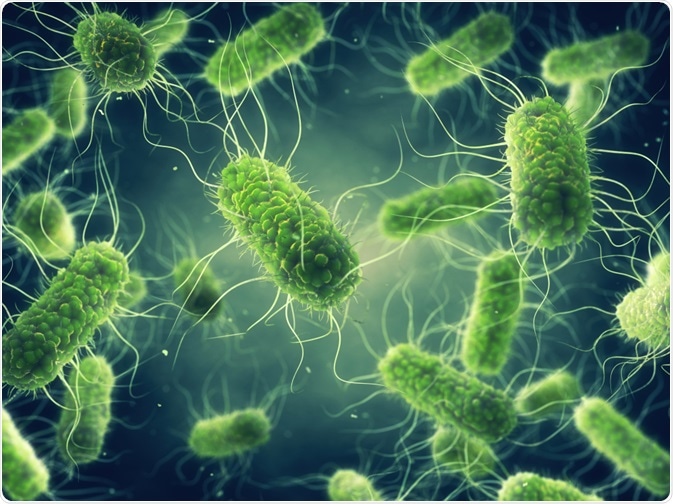Approaches to treating cancer are as varied and numerous as cancers themselves, ranging from the more common surgical, chemotherapeutic, and radiotherapeutic strategies to more recently developed immunotherapeutic and gene-editing approaches. Thanks to recent advancements in our ability to edit the genome, some research groups are working towards creating therapeutic bacteria with applications in a wide range of diseases.

Image Credit: nobeastsofierce/Shuttershock.com
These microorganisms can penetrate deeply into the disordered parenchyma of tumors better than many other small-molecule chemotherapeutic drugs. Once in position, they can be engineered to innately produce compounds of interest, such as one or more anti-cancer drugs with potentially synergistic effects. Many anaerobic bacteria are innately tumor-targeting and destroying and can be modified to ensure they are non-pathogenic towards humans while maintaining this property.
History of bacteriotherapy
Utilizing bacteria for cancer treatment has been investigated from as early as the 19th century, with William B. Coley injecting streptococcal organisms into patients with inoperable cancer in 1891. Variations of this treatment have been proved similarly effective against bone and soft-tissue carcinomas in particular.
Over the next several years, thousands of patients received this treatment at his hospital in New York. As radio and chemotherapy became more readily available treatment options, this treatment strategy fell into disuse; many other medical researchers at the time did not believe the therapy could be effective.
We can now appreciate that this could be considered an early form of immunotherapy, inducing the innate immune system to attack cancerous tissue or cells by exposure to mild pathogens.
Targeting tumors with bacteria
Many research groups aiming to produce bacteria-based cancer therapies have demonstrated the ability to generate highly specific tumor-targeting strains that accumulate exclusively in the desired location following intravenous administration. Both active and passive targeting mechanisms have achieved this. Passive mechanisms refer to entrapment within the tumor's highly fenestrated and disordered vasculature during regular circulation, while active are those driven by interactions between the bacteria and the tumor.
Bacteria may be assisted in passive accumulation within tumors by releasing of inflammatory agents such as tumor necrosis factor-α, which then serve to “seal” the bacteria within.
Active targeting usually refers to the addition of ligands that facilitate a complimentary interaction with cell surface receptors, allowing entry. Other innately present physicochemical interactions can induce the accumulation of bacteria within tumors, such as anaerobes being drawn in by the low oxygen environment of tumor tissue.
Interactions with a higher specificity may also be utilized for localization. For example, Listeria bacterium can infect dendritic cells, macrophages, and myeloid-derived suppressor cells, which are then directly delivered to the tumor. Here, bacteria are protected from immune cells while in transit to the tumor site, whereas any that remain in healthy tissue are quickly eliminated.
As long as energy can be drawn from the environment via metabolic processes, these self-propelling microorganisms can disperse deeply and widely throughout the tumor tissue.
Indeed, many studies have demonstrated that three distinct types of colonies frequently appear throughout the tumor once bacteria are applied: large proliferating colonies near blood vessels and smaller colonies nearby or deep into the tissue.
Some bacteria are more efficient at selectively targeting and penetrating tumor tissue than others, with modified forms of the bacterial strain S. Typhimurium having demonstrated tumor:healthy tissue uptake preference ratios as high as 10,000:1.
Introducing specific nutrient-dependent mutations to bacteria has also been attempted with success, removing the ability to metabolize molecules found throughout the body, such as arginine, while promoting the metabolism of purines, which are more common within tumors. Colony growth is therefore encouraged within tumors rather than elsewhere in the body.
Tumor therapy with bacteria
Once within a tumor, bacteria can innately induce tumor regression by various mechanisms: inducing apoptosis or autophagy, producing toxins, consuming nutrients competitively, upregulation of antigens that inform dendritic cells, and downregulation of immunosuppressive enzymes. Many immune cells migrate to the site of infection and subsequently produce cytokines and chemokines such as interleukin and tumor necrosis factor, which then activate T cells and natural killer cells.
As discussed, modern gene-editing technology allows microorganisms to be repurposed as an anti-cancer agent, with one of the most vital alterations being virulence attenuation. This process enables toxic strains to be better utilized and ensures that the immune system does not attack the bacteria prematurely.
Note that many of the anti-tumor actions of bacteria are the result of their virulence. Ensuring that such strains are non-pathogenic to humans while maintaining their potency towards tumors is crucial. For instance, Salmonella strains have been engineered to remove genes responsible for virulence and the capacity to produce inflammasomes and proinflammatory cytokines retained.
The metabolism of a bacterium can be engineered to produce a particular molecule of interest, often a cytotoxic drug utilized in cancer therapy. These drugs are toxic to all cells, so imbuing the bacteria with a triggered production or release signal once within the tumor would be advantageous over regular chemotherapy in lessening off-target effects.
Many tumors exhibit low oxygen and pH levels, which bacteria have exploited in drug delivery scenarios. For example, a bacterium can be made to express the molecule only when under anaerobic conditions. As bacteria congregate in large numbers within the tumor, quorum sensing can trigger drug production. Introducing other external triggers, such as chemicals or light, can also be applied to achieve the same result.
Further Reading